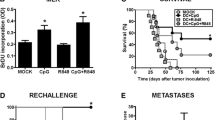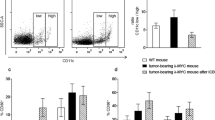Abstract
Purpose
Regulatory T cells (Tregs) impair the clinical benefit of cancer immunotherapy. To optimize the antitumor efficacy of therapeutic dendritic cell (DC) vaccines, we aimed to inhibit Foxp3, a transcription factor required for Treg function.
Methods
Mice bearing established syngeneic LM3 and 4T1 breast tumors were treated with antitumor DC vaccines and a synthetic peptide (P60) that has been shown to inhibit Foxp3.
Results
Treatment with P60 improved the therapeutic efficacy of DC vaccines in these experimental models. In addition, monotherapy with P60 inhibited tumor growth in immunocompetent as well as in immuno-compromised animals bearing established tumors. We found expression of Foxp3 in human and murine breast tumor cells. P60 inhibited IL-10 secretion in breast cancer cells that expressed Foxp3.
Conclusions
Our results suggest that Foxp3 blockade improves the therapeutic efficacy of DC vaccines by inhibition of Tregs and through a direct antitumor effect. This strategy could prove useful to neutralize the immunosuppressive microenvironment and to boost antitumor immunity in breast cancer.







Similar content being viewed by others
References
Adris S et al (2000) Mice vaccination with interleukin 12-transduced colon cancer cells potentiates rejection of syngeneic non-organ-related tumor cells. Can Res 60:6696–6703
Arce Vargas F et al (2017) Fc-optimized anti-CD25 depletes tumor-infiltrating regulatory T cells and synergizes with PD-1 blockade to eradicate established tumors. Immunity 46:577–586. doi:10.1016/j.immuni.2017.03.013
Asad AS et al (2017) Viral gene therapy for breast cancer: progress and challenges. Expert Opin Biol Ther 17:945–959. doi:10.1080/14712598.2017.1338684
Banerjee DK, Dhodapkar MV, Matayeva E, Steinman RM, Dhodapkar KM (2006) Expansion of FOXP3 high regulatory T cells by human dendritic cells (DCs) in vitro and after injection of cytokine-matured DCs in myeloma patients. Blood 108:2655–2661. doi:10.1182/blood-2006-03-011353
Bates GJ, Fox SB, Han C, Leek RD, Garcia JF, Harris AL, Banham AH (2006) Quantification of regulatory T cells enables the identification of high-risk breast cancer patients and those at risk of late relapse. J Clin Oncol 24:5373–5380. doi:10.1200/JCO.2006.05.9584
Berntsen A, Brimnes MK, thor Straten P, Svane IM (2010) Increase of circulating CD4+CD25highFoxp3+ regulatory T cells in patients with metastatic renal cell carcinoma during treatment with dendritic cell vaccination and low-dose interleukin-2. J Immunother 33:425–434. doi:10.1097/CJI.0b013e3181cd870f
Borras-Cuesta F et al (1991) Insights on the amino acid side-chain interactions of a synthetic T-cell determinant. Biologicals 19:187–190
Candolfi M et al (2011) B cells are critical to T-cell-mediated antitumor immunity induced by a combined immune-stimulatory/conditionally cytotoxic therapy for glioblastoma. Neoplasia 13:947–960
Casares N et al (2010) A peptide inhibitor of FOXP3 impairs regulatory T cell activity and improves vaccine efficacy in mice. J Immunol 185:5150–5159. doi:10.4049/jimmunol.1001114
Condamine T, Ramachandran I, Youn JI, Gabrilovich DI (2015) Regulation of tumor metastasis by myeloid-derived suppressor cells. Annu Rev Med 66:97–110. doi:10.1146/annurev-med-051013-052304
de Matos DC, de Ribeiro LC, Tansini A, Ferreira LS, Placeres MC, Colombo LL, Carlos IZ (2012) Immunological response in mice bearing LM3 breast tumor undergoing pulchellin treatment. BMC Complement Altern Med 12:107. doi:10.1186/1472-6882-12-107
Franco-Molina MA et al (2016) Silencing of Foxp3 delays the growth of murine melanomas and modifies the tumor immunosuppressive environment. Onco Targets Ther 9:243–253. doi:10.2147/OTT.S90476
Francois V et al (2009) The CD4(+) T-cell response of melanoma patients to a MAGE-A3 peptide vaccine involves potential regulatory T cells. Can Res 69:4335–4345. doi:10.1158/0008-5472.CAN-08-3726
Gobert M et al (2009) Regulatory T cells recruited through CCL22/CCR4 are selectively activated in lymphoid infiltrates surrounding primary breast tumors and lead to an adverse clinical outcome. Can Res 69:2000–2009. doi:10.1158/0008-5472.CAN-08-2360
Hinz S et al (2007) Foxp3 expression in pancreatic carcinoma cells as a novel mechanism of immune evasion in cancer. Can Res 67:8344–8350. doi:10.1158/0008-5472.CAN-06-3304
Hirano F et al (2005) Blockade of B7-H1 and PD-1 by monoclonal antibodies potentiates cancer therapeutic immunity. Can Res 65:1089–1096
Holmgaard RB, Zamarin D, Munn DH, Wolchok JD, Allison JP (2013) Indoleamine 2,3-dioxygenase is a critical resistance mechanism in antitumor T cell immunotherapy targeting CTLA-4. J Exp Med 210:1389–1402. doi:10.1084/jem.20130066
Jacob JB, Kong YC, Meroueh C, Snower DP, David CS, Ho YS, Wei WZ (2007) Control of Her-2 tumor immunity and thyroid autoimmunity by MHC and regulatory T cells. Can Res 67:7020–7027. doi:10.1158/0008-5472.CAN-06-4755
Jacob JB, Kong YC, Nalbantoglu I, Snower DP, Wei WZ (2009) Tumor regression following DNA vaccination and regulatory T cell depletion in neu transgenic mice leads to an increased risk for autoimmunity. J Immunol 182:5873–5881. doi:10.4049/jimmunol.0804074
Karanikas V et al (2008) Foxp3 expression in human cancer cells. J Transl Med 6:19. doi:10.1186/1479-5876-6-19
Kim SH, Castro F, Paterson Y, Gravekamp C (2009) High efficacy of a Listeria-based vaccine against metastatic breast cancer reveals a dual mode of action. Can Res 69:5860–5866. doi:10.1158/0008-5472.CAN-08-4855
Lechner MG et al (2013) Immunogenicity of murine solid tumor models as a defining feature of in vivo behavior and response to immunotherapy. J Immunother 36:477–489. doi:10.1097/01.cji.0000436722.46675.4a
Liyanage UK et al (2002) Prevalence of regulatory T cells is increased in peripheral blood and tumor microenvironment of patients with pancreas or breast adenocarcinoma. J Immunol 169:2756–2761
Lozano TGM, Lasarte-Cía A, Ruiz M, Rabal O, Oyarzabal J, Hervás-Stubbs S, Llopiz D, Sarobe P, Prieto J, Casares N, Lasarte JJ (2017) Blockage of FOXP3 transcription factor dimerization and FOXP3/AML1 interaction inhibits T regulatory cell activity: sequence optimization of a peptide inhibitor. Oncotarget. doi:10.18632/oncotarget.17845
Lu H (2009) FOXP3 expression and prognosis: role of both the tumor and T cells. J Clin Oncol 27:1735–1736. doi:10.1200/JCO.2008.20.0675
Merlo A et al (2009) FOXP3 expression and overall survival in breast cancer. J Clin Oncol 27:1746–1752. doi:10.1200/JCO.2008.17.9036
Miranda-Hernandez DF et al (2013) Expression of Foxp3, CD25 and IL-2 in the B16F10 cancer cell line and melanoma is correlated with tumor growth in mice. Oncol Lett 6:1195–1200. doi:10.3892/ol.2013.1526
Moreno Ayala MA, Gottardo MF, Asad AS, Zuccato C, Nicola A, Seilicovich A, Candolfi M (2017) Immunotherapy for the treatment of breast cancer. Expert Opin Biol Ther. doi:10.1080/14712598.2017.1324566
Moreno Ayala MA et al (2017) Dual activation of Toll Like Receptors 7 and 9 impairs the efficacy of antitumor vaccines in murine models of metastatic breast cancer. J Cancer Res Clin Oncol. doi:10.1007/s00432-017-2421-7
Morris MC, Deshayes S, Heitz F, Divita G (2008) Cell-penetrating peptides: from molecular mechanisms to therapeutics. Biol Cell 100:201–217. doi:10.1042/BC20070116
Nicholaou T et al (2009) Regulatory T-cell-mediated attenuation of T-cell responses to the NY-ESO-1 ISCOMATRIX vaccine in patients with advanced malignant melanoma. Clin Cancer Res 15:2166–2173. doi:10.1158/1078-0432.CCR-08-2484
Nishikawa H, Sakaguchi S (2014) Regulatory T cells in cancer immunotherapy. Curr Opin Immunol 27:1–7. doi:10.1016/j.coi.2013.12.005
Oleinika K, Nibbs RJ, Graham GJ, Fraser AR (2013) Suppression, subversion and escape: the role of regulatory T cells in cancer progression. Clin Exp Immunol 171:36–45. doi:10.1111/j.1365-2249.2012.04657.x
Pallasch CP et al (2014) Sensitizing protective tumor microenvironments to antibody-mediated therapy. Cell 156:590–602. doi:10.1016/j.cell.2013.12.041
Palucka K, Banchereau J (2012) Cancer immunotherapy via dendritic cells. Nat Rev Cancer 12:265–277. doi:10.1038/nrc3258
Pelleitier M, Montplaisir S (1975) The nude mouse: a model of deficient T-cell function. Methods Achiev Exp Pathol 7:149–166
Rech AJ, Vonderheide RH (2009) Clinical use of anti-CD25 antibody daclizumab to enhance immune responses to tumor antigen vaccination by targeting regulatory T cells. Ann N Y Acad Sci 1174:99–106. doi:10.1111/j.1749-6632.2009.04939.x
Recouvreux MS et al (2016) RUNX1 and FOXP3 interplay regulates expression of breast cancer related genes. Oncotarget 7:6552–6565. doi:10.18632/oncotarget.6771
Sato T, Terai M, Tamura Y, Alexeev V, Mastrangelo MJ, Selvan SR (2011) Interleukin 10 in the tumor microenvironment: a target for anticancer immunotherapy. Immunol Res 51:170–182. doi:10.1007/s12026-011-8262-6
Sharabi AB et al (2015) Stereotactic radiation therapy augments antigen-specific PD-1-mediated antitumor immune responses via cross-presentation of tumor antigen. Cancer Immunol Res 3:345–355. doi:10.1158/2326-6066.CIR-14-0196
Soriano JL et al (2011) Metronomic cyclophosphamide and methotrexate chemotherapy combined with 1E10 anti-idiotype vaccine in metastatic breast cancer. Int J Breast Cancer 2011:710292. doi:10.4061/2011/710292
Soule HD et al (1990) Isolation and characterization of a spontaneously immortalized human breast epithelial cell line, MCF-10. Can Res 50:6075–6086
Subik K et al (2010) The expression patterns of ER, PR, HER2, CK5/6, EGFR, Ki-67 and AR by immunohistochemical analysis in breast cancer cell lines. Breast Cancer 4:35–41
Takenaka M et al (2013) FOXP3 expression in tumor cells and tumor-infiltrating lymphocytes is associated with breast cancer prognosis. Mol Clin Oncol 1:625–632. doi:10.3892/mco.2013.107
Tkach M et al (2012) Targeting Stat3 induces senescence in tumor cells and elicits prophylactic and therapeutic immune responses against breast cancer growth mediated by NK cells and CD4+ T cells. J Immunol 189:1162–1172. doi:10.4049/jimmunol.1102538
Triulzi T, Tagliabue E, Balsari A, Casalini P (2013) FOXP3 expression in tumor cells and implications for cancer progression. J Cell Physiol 228:30–35. doi:10.1002/jcp.24125
Tsai BY, Suen JL, Chiang BL (2010) Lentiviral-mediated Foxp3 RNAi suppresses tumor growth of regulatory T cell-like leukemia in a murine tumor model. Gene Ther 17:972–979. doi:10.1038/gt.2010.38
Urtreger A, Ladeda V, Puricelli L, Rivelli A, Vidal M, Delustig E, Joffe E (1997) Modulation of fibronectin expression and proteolytic activity associated with the invasive and metastatic phenotype in two new murine mammary tumor cell lines. Int J Oncol 11:489–496
Valzasina B, Piconese S, Guiducci C, Colombo MP (2006) Tumor-induced expansion of regulatory T cells by conversion of CD4+ CD25- lymphocytes is thymus and proliferation independent. Can Res 66:4488–4495. doi:10.1158/0008-5472.CAN-05-4217
Vasir B et al (2008) Fusions of dendritic cells with breast carcinoma stimulate the expansion of regulatory T cells while concomitant exposure to IL-12, CpG oligodeoxynucleotides, and anti-CD3/CD28 promotes the expansion of activated tumor reactive cells. J Immunol 181:808–821
Vendrell A et al (2011) A novel Salmonella Typhi-based immunotherapy promotes tumor killing via an antitumor Th1-type cellular immune response and neutrophil activation in a mouse model of breast cancer. Vaccine 29:728–736. doi:10.1016/j.vaccine.2010.11.017
Wang X et al (2016) Prospective study of cyclophosphamide, thiotepa, carboplatin combined with adoptive DC-CIK followed by metronomic cyclophosphamide therapy as salvage treatment for triple negative metastatic breast cancers patients (aged < 45). Clin Transl Oncol 18:82–87. doi:10.1007/s12094-015-1339-2
Welters MJ et al (2008) Induction of tumor-specific CD4+ and CD8+ T-cell immunity in cervical cancer patients by a human papillomavirus type 16 E6 and E7 long peptides vaccine. Clin Cancer Res 14:178–187. doi:10.1158/1078-0432.CCR-07-1880
Wolf D et al (2005) The expression of the regulatory T cell-specific forkhead box transcription factor FoxP3 is associated with poor prognosis in ovarian cancer. Clin Cancer Res 11:8326–8331. doi:10.1158/1078-0432.CCR-05-1244
Xie X, Stubbington MJ, Nissen JK, Andersen KG, Hebenstreit D, Teichmann SA, Betz AG (2015) The regulatory T cell lineage factor Foxp3 regulates gene expression through several distinct mechanisms mostly independent of direct DNA binding. PLoS Genet 11:e1005251. doi:10.1371/journal.pgen.1005251
Acknowledgements
This work was supported by Consejo Nacional de Investigaciones Científicas y Tecnológicas (CONICET-PIP114-201101-00353 to M.C.; PIP11220120100261 to A.S.); Doctoral Fellowship to M.A.M.A., M.F.G. and A.S.A.); ANPYCT (PICT-2012-0830; PICT-2013-0310, PICT-2015-3309 to M.C.; PICT 2014-0334 to A.S.); Fundación Bunge y Born (“Jorge Oster” fellowship to M.A.M.A) and LALCEC fellowship to M.A.M.A. and by grants from Ministerio de Educación y Ciencia de España (SAF2016-78568-R), Fundación Ramón Areces and Gobierno de Navarra.
Author information
Authors and Affiliations
Corresponding author
Ethics declarations
Conflict of interest
All the authors declare no conflict of interest.
Electronic supplementary material
Below is the link to the electronic supplementary material.
Rights and permissions
About this article
Cite this article
Moreno Ayala, M.A., Gottardo, M.F., Imsen, M. et al. Therapeutic blockade of Foxp3 in experimental breast cancer models. Breast Cancer Res Treat 166, 393–405 (2017). https://doi.org/10.1007/s10549-017-4414-2
Received:
Accepted:
Published:
Issue Date:
DOI: https://doi.org/10.1007/s10549-017-4414-2




